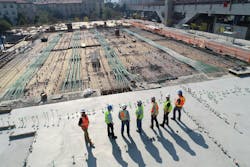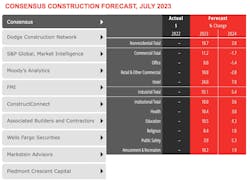Leading economists call for 2% increase in building construction spending in 2024
By BD+C and AIA
Following a 19.7% surge in spending for commercial, institutional, and industrial buildings in 2023, leading construction industry economists expect spending growth to come back to earth in 2024, according to the July 2023 AIA Consensus Construction Forecast Panel.
The twice-yearly Consensus Construction report aggregates building construction spending forecasts from nine leading economists:
- Richard Branch, Dodge Construction Network
- Scott Hazelton, S&P Global
- Steven Shields, Moody's Analytics
- Brian Strawberry, FMI
- Alex Carrick, ConstructConnect
- Anirban Basu, Associated Builders and Contractors
- Charles Dougherty, Wells Fargo Securities
- Bernard Markstein, Markstein Advisors
- Mark Vitner, Piedmont Crescent Capital
All nine economists are in agreement on a 2024 spending-growth slowdown. Two economists are calling for a contraction in spending (Wells Fargo, -1.0%; Piedmont Crescent Capital, -4.7%). ABC's Anirban Basu is the most bullish on 2024, predicting a 7.7% increase in overall building spending.
"The first half of this year has seen gains in construction spending on nonresidential buildings approaching 20%. However, this scorching growth rate is expected to moderate a bit moving into the third and fourth quarters," wrote AIA Chief Economist Kermit Baker, Hon. AIA, in the report. "Even with the easing in supply chain issues and the improved pricing of many construction materials and products, elevated interest rates, more restrictive lending on the part of banks, nervousness over the direction of the economy, and construction labor constraints are expected to slow the pace of growth."
Bright spots for the remainder of 2023 and 2024 include:
- Healthcare, driven by the aging baby boom population
- Manufacturing/distribution, thanks to the post-Covid reshoring of production resulting from supply chain issues during the pandemic
- Hotels, with leisure travel returning to normal following the pandemic
- Education, as school districts and higher education institutions play catch-up on projects in the wake of Covid.
"There are emerging concerns that outsourcing the manufacturing of high-tech products leaves our economy and national defense more vulnerable," Baker wrote. "The $280 billion in funding provided by the 2022 federal CHIPS and Science Act is designed to advance domestic research and manufacturing of semiconductors in the United States. These funds will boost spending for these facilities for much of the coming decade."
View the full AIA Consensus Construction Forecast Panel report, including an interactive table with market forecasts from all nine economists.

